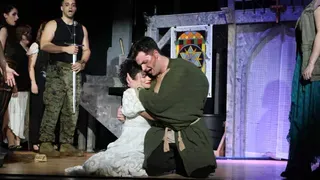February 7, 2014
The Whipping Man
Michael Cox READ TIME: 4 MIN.
In a pivotal scene of Matthew Lopez' thought provoking play "The Whipping Man," a three men observe the rites of the beginning of Passover which, in April of 1865, happens to coincide with the end of the Civil War. This religious ceremony conjures another religious ritual, the Greek tragedy. And the familial bonds of love and sadism in this play are on par with Euripides.
New Repertory Theatre brings this regional theatre favorite of 2012 to New England for the first time through February 15 at the Charles Mosesian Theater at the Arsenal Center for the Arts, 321 Arsenal St., Watertown, MA. Tickets are available at newrep.org or by calling the box office at 617-923-8487.
It's a makeshift celebration as the characters in this play sit down to their Seder table to symbolically remember the release of the Israelites from their slavery in Egypt. The timing of the event is made even more ironic by the fact that two of these men have been American slaves and the other has been their master.
The DeLeon family of Richmond, Virginia is Jewish and they have raised their slaves in that tradition. The family that owns the great mansion that serves as the setting obviously cared about the people they owned. They shared their religion. Mind you, this particular belief system would be an intimate part of a Civil War Southerner. Not only was it condemned by most of the society, it is certainly not a evangelical religion like Christianity: the only people that a Jewish man wants to be Jewish with him is... well his family.
As soon as the play begins, the stage is filled with action, rather than light. A wounded solder has broken into the estate, and the only individual left in this dilapidated Southern mansion that has been looted, destroyed and abandoned is Simon (Johnny Lee Davenport,) the family's head slave.
The trespasser happens to actually be one of the family's offspring, Caleb DeLeon (Jesse Hinson,) who left home to fight for the Confederacy. Simon has raised this man since he was a boy, and now Caleb's leg is badly wounded -- gangrene has set in and the limb must be amputated.
The vividness of the experience, the description of the process, is so graphic it evokes the best-written documentation of the bloodiest war ever fought on our country's soil. But this is, pretty much, where historical reenactment ends. The play is not a documentary, but a theatrical ceremony.
One more character will enter the picture, John (Keith Mascoll,) the companion and personal slave to Caleb. The inequity of this brotherhood will explain the central theme and title of the play.
Janie Howland's scenic design is operatic and rich with metaphor. Like in Greek Tragedy, the action takes place at the entrance of a great house, only in this case we are on the inside of the house rather than on the outside. In keeping with the tradition of American tragedy, there are no great and powerful men. The house is the symbol of nobility, and this burned-down, evacuated location is a synecdoche for its geographic location, the capital of the Confederacy.
There is no chorus, but the play is filled with music: there's Simon's haunting rendition of the spiritual "Go Down, Moses" and John's gut-wrenching recollection of a whipping, the sounds of which are recreated through stomping his foot and clapping his hands.
As directed by Benny Sato Ambush, the action is very grand; to be fair, these are spectacular emotions the characters are feeling. But the genuine faith and devotion of the Seder scene made me long for the intimacy of the Black Box Theater and "Imagining Madoff."
I longed for some kind of redemption in Caleb's character, some sign that the love he claims he has for a person who used to be his property is sincere. But the only opportunity for him to express this feeling is in the recitation of a letter. This event felt pronounced and theatrical, and not like an attempt to communicate honestly with another human being.
So the grandeur of the setting and the epic scope of the family's betrayals is in direct contrast with the humility of the Seder ritual. If the DeLeon house is the Vatican, the Seder is Mother Teresa.
In Greek tragedy, family members murder each other, here they enslave each other. We can tell ourselves that the days of our countrymen beating and bartering for each other are long over, but what tragedy constantly reminds us is human beings will always hurt the people they love.
Though the vile practice of slavery created the DeLeon household, it was the Civil War that forged it and made it into a family.
New Repertory Theatre
"The Whipping Man"
through Feb 16
newrep.org / Arsenal Center for the Arts / 617-923-8487




